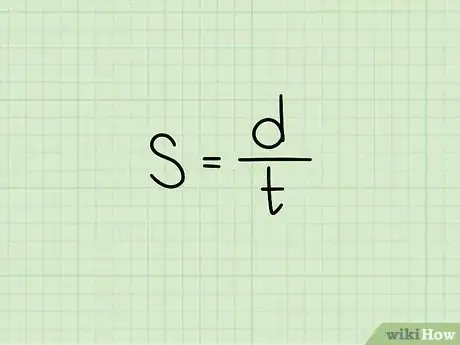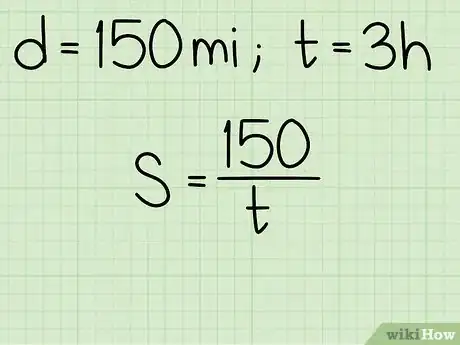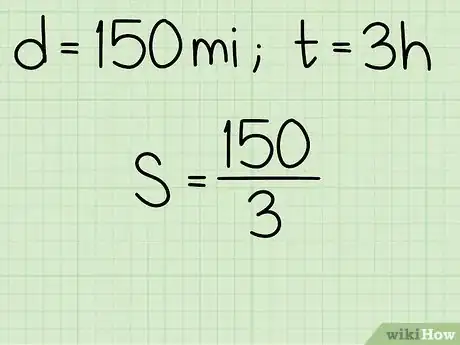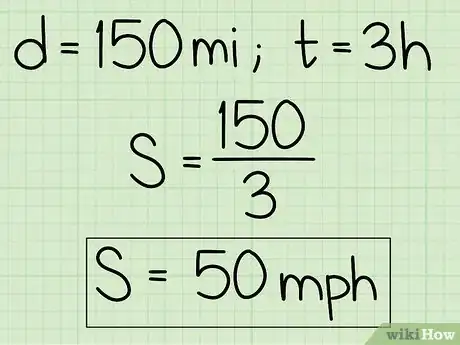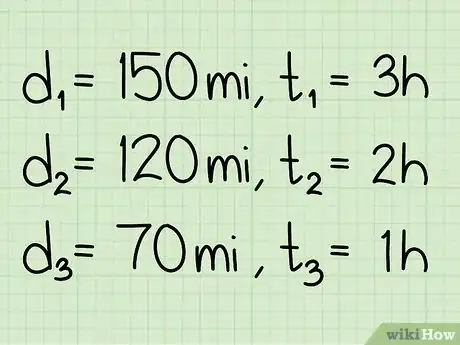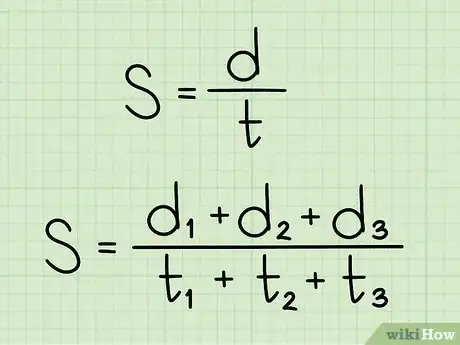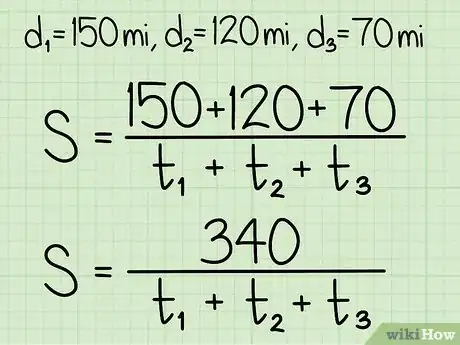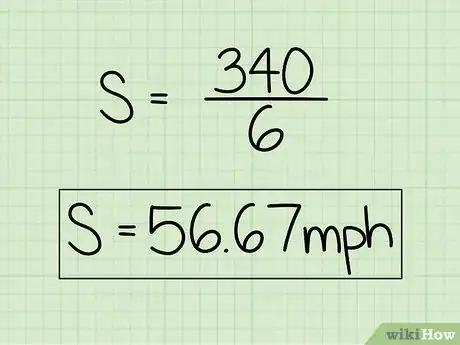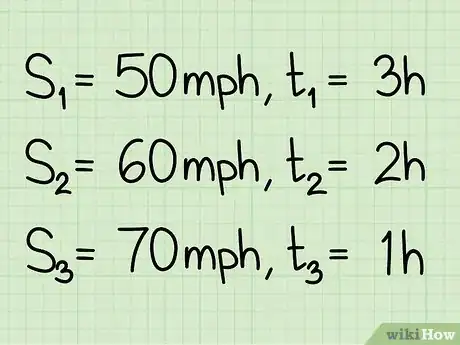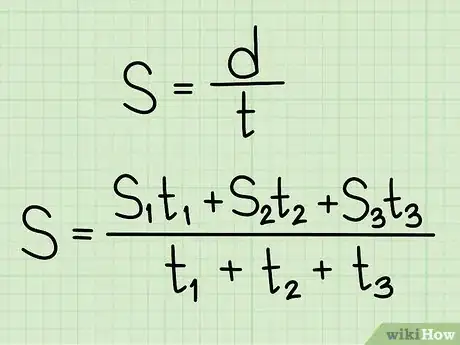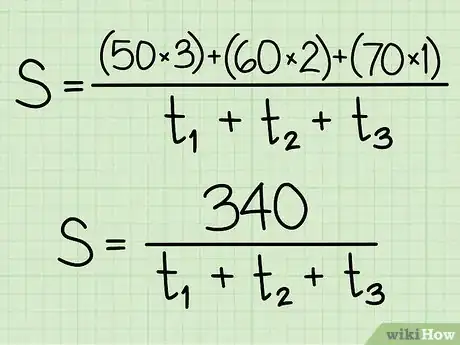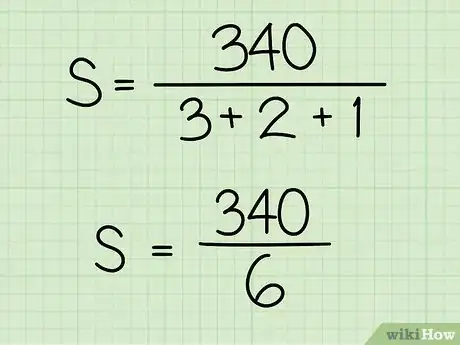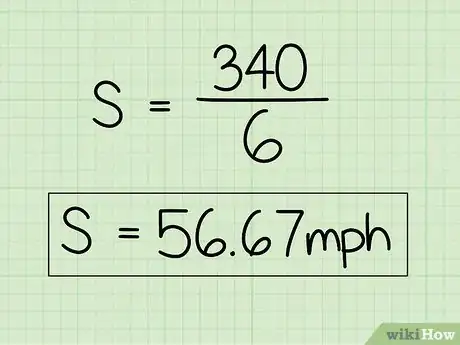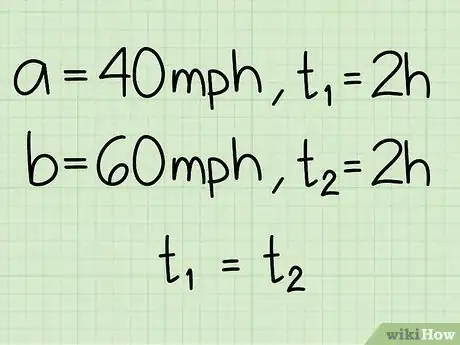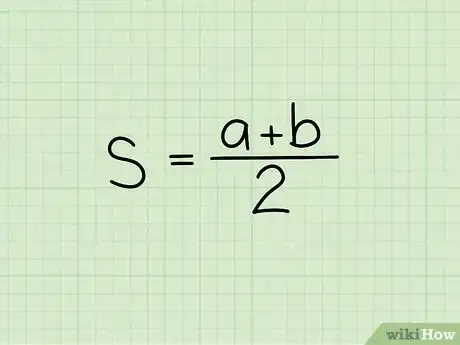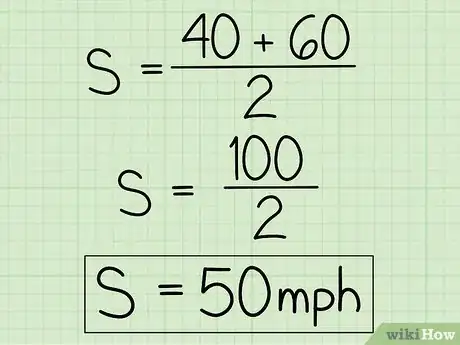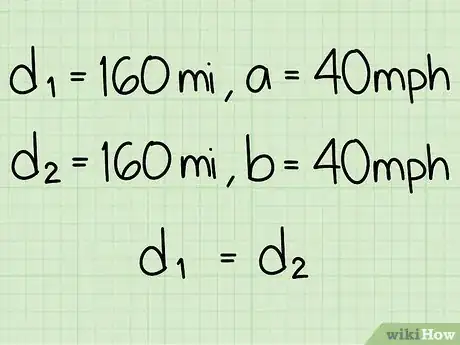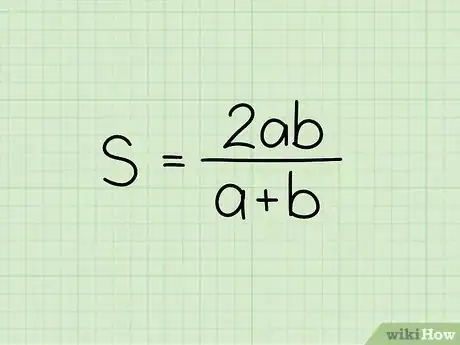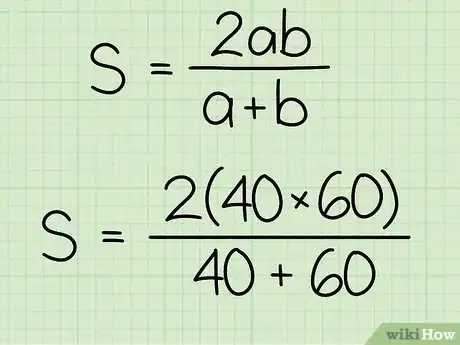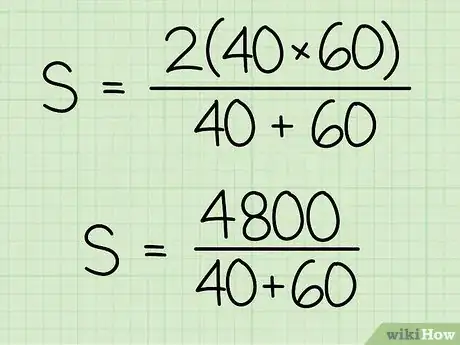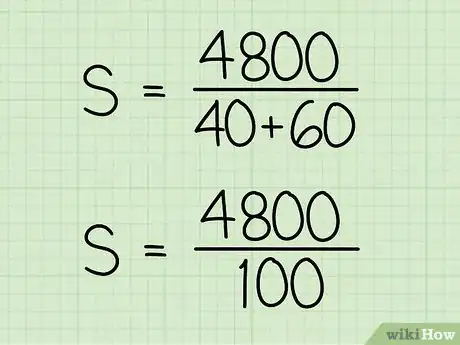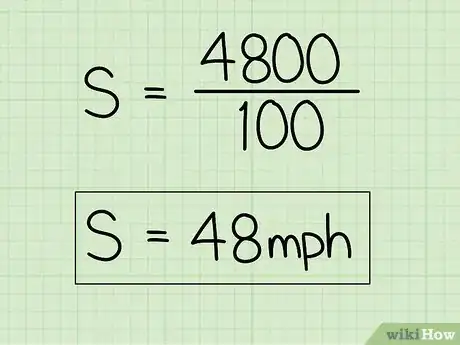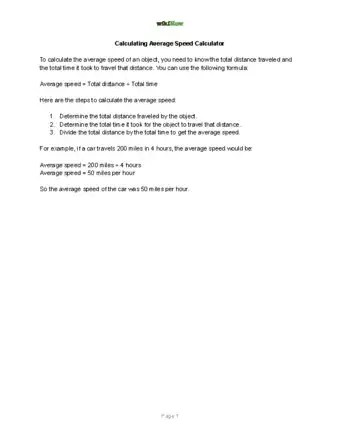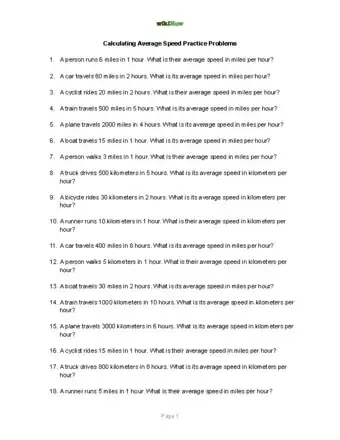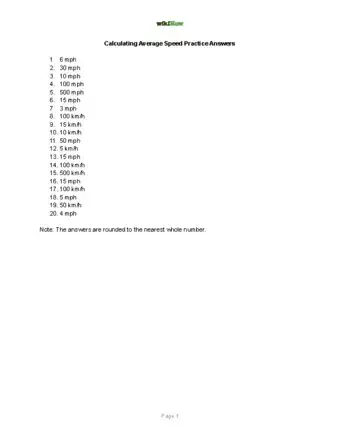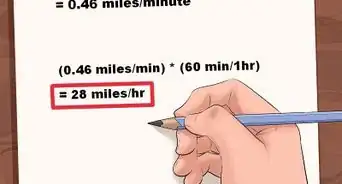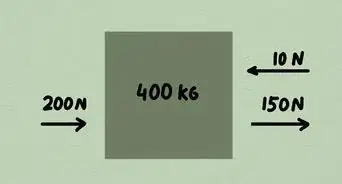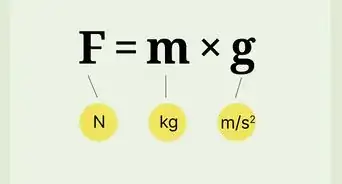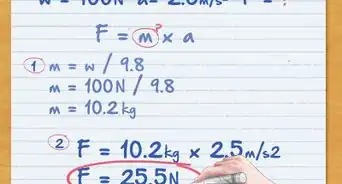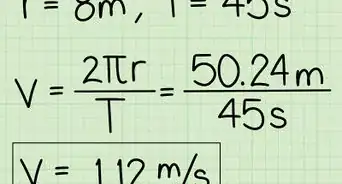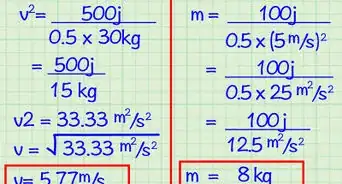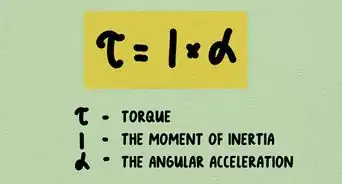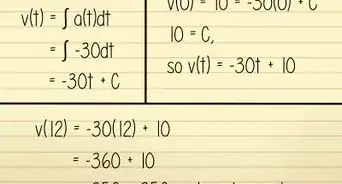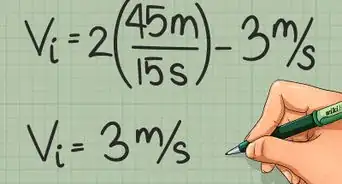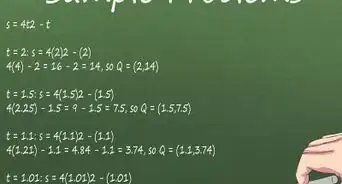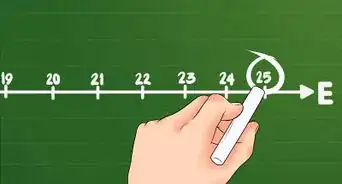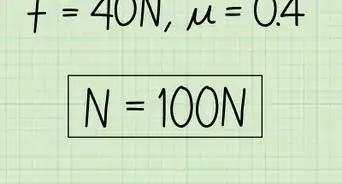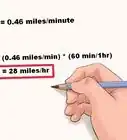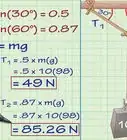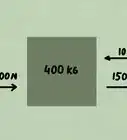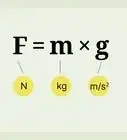This article was co-authored by wikiHow Staff. Our trained team of editors and researchers validate articles for accuracy and comprehensiveness. wikiHow's Content Management Team carefully monitors the work from our editorial staff to ensure that each article is backed by trusted research and meets our high quality standards.
This article has been viewed 1,197,382 times.
Learn more...
Often calculating the average speed is simple using the formula . But sometimes you are given two different speeds used for some periods of time, or over some distances. In these instances, other formulas exist for calculating the average speed. These types of problems might be useful to you in real life, and often appear on standardized tests, so it is helpful to learn these formulas and methods.
Steps
Given One Distance and One Time Period
-
1Assess what information you are given. Use this method if you know:
- the total distance covered by one person or vehicle; and
- the total time it took that person or vehicle to cover the distance.
- For example:[1] If Ben traveled 150 miles in 3 hours, what was his average speed?
-
2Set up the formula for speed. The formula is , where equals the average speed, equals the total distance, and equals the total time.[2]Advertisement
-
3Plug the distance into the formula. Remember to substitute for the variable .
- For example, if Ben drives 150 total miles, your formula will look like this: .
-
4Plug the time into the formula. Remember to substitute for the variable .
- For example, if Ben drives for 3 hours, your formula will look like this: .
-
5Divide the distance by the time. This will give you the average speed per unit of time, usually hour.
- For example:
So, if Ben traveled 150 miles in 3 hours, his average speed is 50 miles per hour.
- For example:
Given Multiple Distances in Different Amounts of Time
-
1Assess what information you are given. Use this method if you know:
- multiple distances that were traveled; and
- the amount of time it took to travel each of those distances.[3]
- For example: If Ben traveled 150 miles in 3 hours, 120 miles in 2 hours, and 70 miles in 1 hour, what was his average speed for the entire trip?
-
2Set up the formula for average speed. The formula is , where equals the average speed, equals the total distance, and equals the total time.[4]
-
3Determine the total distance. To do this, add up the number of miles traveled during the entire trip. Substitute this value for in the formula.
- For example, If Ben traveled 150 miles, 120 miles, and 70 miles, you would determine the total speed by adding the three distances together: . So, your formula will look like this: .
-
4Determine the total time. To do this, add up the times, usually hours, that were spent traveling. Substitute this value for in the formula.
- For example, If Ben for 3 hours, 2 hours, and 1 hour, you would determine the total time by adding the three times together: . So, your formula will look like this: .
-
5Divide the total distance traveled by the total time spent traveling. This will give you your average speed.
- For example:
. So if Ben traveled 150 miles in 3 hours, 120 miles in 2 hours, and 70 miles in 1 hour, his average speed was about 57 mph.
- For example:
Given Multiple Speeds for Different Amounts of Time
-
1Assess what information you are given. Use this method if you know:
- multiple speeds used to travel; and
- the amount of time each of those speeds was traveled for.[5]
- For example: For example: If Ben traveled 50 mph for 3 hours, 60 mph for 2 hours, and 70 mph for 1 hour, what was his average speed for the entire trip?
-
2Set up the formula for average speed. The formula is , where equals the average speed, equals the total distance, and equals the total time.[6]
-
3Determine the total distance. To do this, separately multiply each speed by each time period. This will give you the distance traveled for each section of the trip. Add up these distances. Substitute this sum for in the formula.
- For example:
50 mph for 3 hours =
60 mph for 2 hours =
70 mph for 1 hour =
So, the total distance is So, your formula will look like this:
- For example:
-
4Determine the total time. To do this, add up the times, usually hours, that were spent traveling. Substitute this value for in the formula.
- For example, If Ben for 3 hours, 2 hours, and 1 hour, you would determine the total time by adding the three times together: . So, your formula will look like this: .
-
5Divide the total distance traveled by the total time spent traveling. This will give you your average speed.
- For example:
. So if Ben traveled 50 mph for 3 hours, 60 mph for 2 hours, and 70 mph for 1 hour, his average speed was about 57 mph.
- For example:
Given Two Speeds for Half the Time
-
1Assess what information you are given. Use this method if you know:
- two or more different speeds; and
- that those speeds were traveled for the same amount of time.
- For example, if Ben drives 40 mph for 2 hours, and 60 mph for another 2 hours, what is his average speed for the entire trip?
-
2Set up the formula for average speed given two speeds used for the same amount of time. The formula is , where equals the average speed, equals the speed for the first half of the time, and equals the speed for the second half of the time.[7]
- In these types of problems, It doesn’t matter for how long each speed is driven, as long as each speed is used for half the total duration of time.
- You can modify the formula if you are given three or more speeds for the same amount of time. For example, or . As long as the speeds were used for the same amount of time, your formula can follow this pattern.
-
3Plug the speeds into the formula. It doesn’t matter which speed you substitute for and which you substitute for .
- For example, if the first speed is 40 mph, and the second speed is 60 mph, your formula will look like this: .
-
4Add the two speeds together. Then, divide the sum by two. This will give you the average speed for the entire trip.
- For example:
So, if Ben traveled 40 mph for 2 hours, then 60 mph for another 2 hours, his average speed is 50 mph.
- For example:
Given Two Speeds for Half the Distance
-
1Assess what information is given. Use this method if you know:
- two different speeds; and
- that those speeds were used for the same distance.
- For example, if Ben drives the 160 miles to the waterpark at 40 mph, and returns the 160 miles home driving 60 mph, what is his average speed for the entire trip?
-
2Set up the formula for average speed given two speeds used for the same distance. The formula is , where equals the average speed, equals the speed for the first half of the distance, and equals the speed for the second half of the distance.[8]
- Often problems requiring this method will involve a question about a return trip.
- In these types of problems, it doesn’t matter how far each speed is driven, as long as each speed is used for half the total distance.
- You can modify the formula if given three speeds for the same distance. For example, .[9]
-
3Plug the speeds into the formula. It doesn’t matter which speed you substitute for and which you substitute for .
- For example, if the first speed is 40 mph, and the second speed is 60 mph, your formula will look like this: .
-
4Multiply the product of the two speeds by 2. This number should be the numerator of your fraction.
- For example:
.
- For example:
-
5Add the two speeds together. This number should be the denominator of your fraction.
- For example:
.
- For example:
-
6Simplify the fraction. This will give you the average speed for the entire trip.
- For example:
. So, if Ben drives 40 mph for 160 miles to the waterpark, then 60 mph for the 160 miles home, his average speed for the trip is 48 mph.
- For example:
Calculator, Practice Problems, and Answers
Community Q&A
-
QuestionAn athlete runs in a circular path with a radius of 14m. The athlete completes 10 rounds in 10 minutes. How do I calculate his speed in m/s?
 Community AnswerTo know how far he runs, you first have to calculate the circumference of the circle. The formula for circumference is 2(pi)(r). So 2(3.14)(14) = 87.92. Since he runs ten rounds, you have to multiply the circumference by 10: 87.92 x 10 = 879.2 (879 rounded) Next, it says he completed the run in 10 minutes, but the answer needs to be in seconds, so convert by multiplying 10 x 60 = 600. Now, you can set up the speed ratio: s = d/t; s = 879/600 Finally, simplify the ratio by dividing 879/600 = 1.47. So his average speed was 1.47 m/s
Community AnswerTo know how far he runs, you first have to calculate the circumference of the circle. The formula for circumference is 2(pi)(r). So 2(3.14)(14) = 87.92. Since he runs ten rounds, you have to multiply the circumference by 10: 87.92 x 10 = 879.2 (879 rounded) Next, it says he completed the run in 10 minutes, but the answer needs to be in seconds, so convert by multiplying 10 x 60 = 600. Now, you can set up the speed ratio: s = d/t; s = 879/600 Finally, simplify the ratio by dividing 879/600 = 1.47. So his average speed was 1.47 m/s -
QuestionHow can I find an average speed of a car if it moves from point A To B at a speed of 30 kilometers per hour and returns at a speed of 50 kilometers per hour?
 Community AnswerSince you have two different speeds for half the distance (A to B = half; B to A = half), use the formula given in method 5: 2ab/a+b. So: (2)(30)(50)/30+50 3000/80 37.5 So, the average speed is 37.5 km/hr
Community AnswerSince you have two different speeds for half the distance (A to B = half; B to A = half), use the formula given in method 5: 2ab/a+b. So: (2)(30)(50)/30+50 3000/80 37.5 So, the average speed is 37.5 km/hr -
QuestionDoes steepness matter when you're finding the average speed?
 Community AnswerNo, the formula for average speed is the same regardless of steepness. If you were calculating velocity, then the direction/incline of the motion would matter.
Community AnswerNo, the formula for average speed is the same regardless of steepness. If you were calculating velocity, then the direction/incline of the motion would matter.
References
- ↑ https://www.cuemath.com/average-speed-formula/
- ↑ http://www.mathsisfun.com/measure/speed-velocity.html
- ↑ https://www.cuemath.com/average-speed-formula/
- ↑ http://www.mathsisfun.com/measure/speed-velocity.html
- ↑ https://www.youtube.com/watch?v=berKGT_5hXE
- ↑ http://www.mathsisfun.com/measure/speed-velocity.html
- ↑ https://www.cuemath.com/average-speed-formula/
- ↑ http://www.educationupdate.com/archives/2007/FEB/html/col-deanscolumn.html
- ↑ http://www.educationupdate.com/archives/2007/FEB/html/col-deanscolumn.html
About This Article
If you need to calculate average speed and you know the total distance covered and the total time it took to cover that distance, divide the distance into the total time. If the fraction doesn’t simplify into a whole number, convert it to a decimal. The result will be the average speed per unit of time, usually an hour. If you want to learn how to calculate average speed if there are multiples distances or amounts of time, keep reading the article!


